Indigenous People’s Month or Native American Heritage Month is celebrated during the month of November and honors the achievements, culture and history of Native American and Indigenous people in the United States. It is a time to recognize the strength and courage of Indigenous communities as they’ve preserved their traditions and culture through centuries of adversary, including mass displacement and colonization. It is also a time to recognize the continued struggles they face, even now. Below is a collection of incredible and inspiring Native American people and their stories.
“We must shift our thinking away from short-term gain toward long-term investment and sustainability, and always have the next generations in mind with every decision we make.”
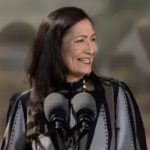 DEB HAALAND, a member of the Laguna Pueblo tribe, made history by becoming the first Native American person to serve as Cabinet Secretary for the United States Congress. During her time with congress, she has put a major focus on the issue of missing and murdered Indigenous women in America. She has worked with law enforcement agencies, tribal governments, families of those missing and murdered, and other members of the community impacted in order to bring attention to this rising crisis. She has also collaborated to create legislation such as the Not Invisible Act, which created a Joint Commission composed of tribal leaders, law enforcement, and advocacy groups to recommend ways for the federal government to tackle violent crimes against Indigenous people.
DEB HAALAND, a member of the Laguna Pueblo tribe, made history by becoming the first Native American person to serve as Cabinet Secretary for the United States Congress. During her time with congress, she has put a major focus on the issue of missing and murdered Indigenous women in America. She has worked with law enforcement agencies, tribal governments, families of those missing and murdered, and other members of the community impacted in order to bring attention to this rising crisis. She has also collaborated to create legislation such as the Not Invisible Act, which created a Joint Commission composed of tribal leaders, law enforcement, and advocacy groups to recommend ways for the federal government to tackle violent crimes against Indigenous people.
“American history is not history without Native history.”
 LILY GLADSTONE, who is of Blackfeet and Nimíipuu descent, has risen to fame recently following her incredible performance in the award-winning film, Killers of a Flower Moon. In the movie, she played an Osage woman during the 1920s that survives a series of murders of Native Americans when oil is discovered on their territory. From this film, she became the first Native American woman to win a Golden Globe, as well as the first Native American to be nominated for an Academy Award for Best Actress. She has appeared in several other critically acclaimed films and shows, including Reservation Dogs, Fancy Dance, and Certain Women.
LILY GLADSTONE, who is of Blackfeet and Nimíipuu descent, has risen to fame recently following her incredible performance in the award-winning film, Killers of a Flower Moon. In the movie, she played an Osage woman during the 1920s that survives a series of murders of Native Americans when oil is discovered on their territory. From this film, she became the first Native American woman to win a Golden Globe, as well as the first Native American to be nominated for an Academy Award for Best Actress. She has appeared in several other critically acclaimed films and shows, including Reservation Dogs, Fancy Dance, and Certain Women.
“I have worked for freedom, I have labored to give my race a voice in the affairs of the nation.”
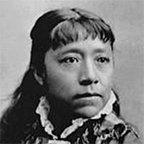 SARAH or THOCMETONY(meaning shellflower) WINNEMUCCA was born in 1844 to the Paiute tribe. She worked as a translator between Native Americans and the US Army during the “Indian Wars” that directly followed the American Civil War. She was an extremely talented author and in 1883, became the first Native American woman to publish an autobiography titled “Life Among the Piutes: Their Wrongs and Claims”. In her writing she stressed that the American people did not follow their own political ideals and exposed the mistreatment the Paiute people faced at the hands of the American public.
SARAH or THOCMETONY(meaning shellflower) WINNEMUCCA was born in 1844 to the Paiute tribe. She worked as a translator between Native Americans and the US Army during the “Indian Wars” that directly followed the American Civil War. She was an extremely talented author and in 1883, became the first Native American woman to publish an autobiography titled “Life Among the Piutes: Their Wrongs and Claims”. In her writing she stressed that the American people did not follow their own political ideals and exposed the mistreatment the Paiute people faced at the hands of the American public.
“Strong alliances can thrive even where disagreements exist, but they cannot thrive where free and open communication is shut down.”
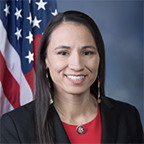 SHARICE DAVIDS is a member of the Ho-Chunk Nation. She was raised by a single mother and worked hard throughout her time as a first-generation college student, eventually obtaining a law degree from Cornell University. In 2019, she became one of the first Native American women to serve in Congress, representing Kansas’s third district, and has served there since. She is also the first openly LGBTQ+ Native American woman to be in Congress.
SHARICE DAVIDS is a member of the Ho-Chunk Nation. She was raised by a single mother and worked hard throughout her time as a first-generation college student, eventually obtaining a law degree from Cornell University. In 2019, she became one of the first Native American women to serve in Congress, representing Kansas’s third district, and has served there since. She is also the first openly LGBTQ+ Native American woman to be in Congress.
“We were born here… where the wind blows free and there is nothing to break the light of the sun. There are no enclosures and everybody draws a free breath.”
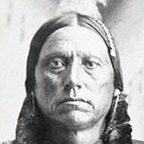 QUANAH PARKER was born in the mid-1840s into the Comanche tribe. He rose to prominence as a fierce warrior, leading his people in resistance against U.S. expansion during the 19th century. In the Red River War, his group was among the last to surrender. After this, he transitioned into advocating for the rights of his people while also helping them adjust to the new reality of reservation life. He became an extremely successful rancher, a respected mediator between his people and the United States, and is widely regarded as being the last Comanche Chief, as after his death, the role was renamed to Chairman.
QUANAH PARKER was born in the mid-1840s into the Comanche tribe. He rose to prominence as a fierce warrior, leading his people in resistance against U.S. expansion during the 19th century. In the Red River War, his group was among the last to surrender. After this, he transitioned into advocating for the rights of his people while also helping them adjust to the new reality of reservation life. He became an extremely successful rancher, a respected mediator between his people and the United States, and is widely regarded as being the last Comanche Chief, as after his death, the role was renamed to Chairman.
“If we must die, we die defending our rights.”
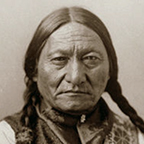 SITTING BULL was a renowned spiritual and military Hunkpapa Lakota Sioux leader known for his resistance to the United State’s relocation policies forced on Native American tribes. As a military leader, he played a pivotal role in several Native American resistances, including the battle of Little Big Horn in 1876. He was also a spiritual leader who advocated for the preservation of Lakota culture and independence. Sitting Bull was commended throughout his life for his generosity, strength, and bravery.
SITTING BULL was a renowned spiritual and military Hunkpapa Lakota Sioux leader known for his resistance to the United State’s relocation policies forced on Native American tribes. As a military leader, he played a pivotal role in several Native American resistances, including the battle of Little Big Horn in 1876. He was also a spiritual leader who advocated for the preservation of Lakota culture and independence. Sitting Bull was commended throughout his life for his generosity, strength, and bravery.
–Isabelle Oppelt
All League News

